Rennie Scaysbrook | July 7, 2022
Everest, Waimea Bay, El Capitan and Dakar are all hallowed grounds for the people who chose to compete on them. For road racers, there’s only one—the Isle of Man. And I give it a go.
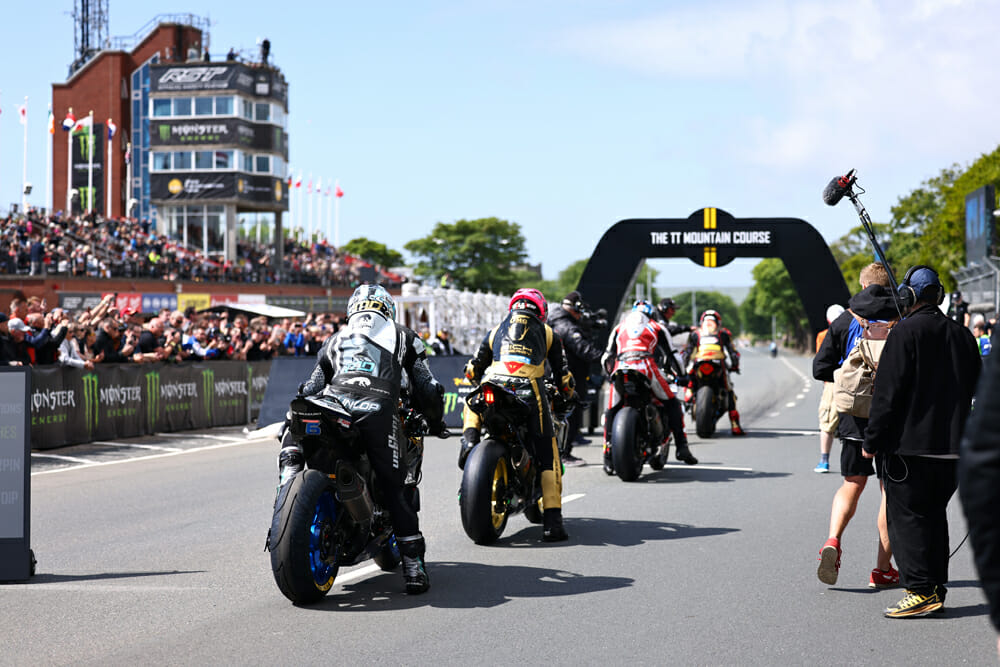 Michael Rutter, Ian Hutchinson, James Hillier and Michael Dunlop (closest) wait their turn to take the most famous start in racing during the 2022 Isle of Man Senior TT.
Michael Rutter, Ian Hutchinson, James Hillier and Michael Dunlop (closest) wait their turn to take the most famous start in racing during the 2022 Isle of Man Senior TT.
Photography by Double Red Photography, Barry Clay
The Quarry Bends is a snaking series of switchbacks that holds one of the many keys to a fast lap of the Isle of Man TT Mountain Course.
Approaching in sixth gear, I knock it back one to fifth and rail past the first right in anticipation of the upcoming left Peter Hickman tells me is the most important corner on the course. That’s because if you get through it correctly, you’ll be able to hold full throttle through the next right/left/right, clicking sixth before the final kink onto the Sulby Straight, the fastest part of the track.
On this particular lap, the third in my final night of practice on Thursday, I know I’ve nailed it. The little Suzuki is wailing its brains out in fifth, I’m counter-steering so hard it feels like I’m rowing through drying cement, and as I click sixth gear, I tuck in and prepare for that last left kink, and my entry, once again, onto the world’s fastest rollercoaster—the Sulby Straight may be straight, but it’s far from smooth.
 Fresh-faced for the first day of school! Rennie in his orange rookie vest, just before the start of the first night of practice.
Fresh-faced for the first day of school! Rennie in his orange rookie vest, just before the start of the first night of practice.
Then, in the space of about 0.7 seconds, I’m sent off course, and the PRF Suzuki is heading towards the trees at near top speed. I didn’t hit anything on the track, nor did something on the bike break. It was simply Jamie Coward on his Superbike-spec Yamaha YZF-R1 going around the outside of me at such a velocity that the air he was pushing was so strong it literally knocked me off my course.
That old racing expression “He came past so quickly, it sucked the stickers off the bike” has never been truer.
Welcome to the Isle of Man, kid.
As John McGuinness says, “The Nurburgring, Pikes Peak, those places are car parks. This is the daddy’s circuit, right here.”
 It takes nearly 2500 volunteers and employees to make the TT run smoothly, with the traveling marshals playing a vital role in getting the riders back to the pits after a red flag.
It takes nearly 2500 volunteers and employees to make the TT run smoothly, with the traveling marshals playing a vital role in getting the riders back to the pits after a red flag.
Taking Part In History
The Isle of Man TT is the world’s oldest motorsports event, having run nearly every year since 1907, save for World War II, the Foot and Mouth epidemic in 2000 and two years of Covid-induced hiatus. The 37.73-mile track is largely the same layout it’s always been; there are still the same dangers, and it is still, after more than a century, the ultimate place to test the mettle of man and machine.
The dangers are undeniable.
Five riders (Mark Purslow, Davy Morgan, sidecar passenger Cesar Chanal and father and son sidecar duo Bradley and Roger Stockton) did not make it home this year, casting a shadow over the TT’s return in the deadliest year since 1989.
It’s a common conundrum of the event that although they passed on, these racers all lined up, as did I, of their own free will, knowing this could indeed be their last ride. The TT is unique. It is one of the few places left in the world where a man or woman can make that choice—to be in command of their bodies and their ultimate destiny.
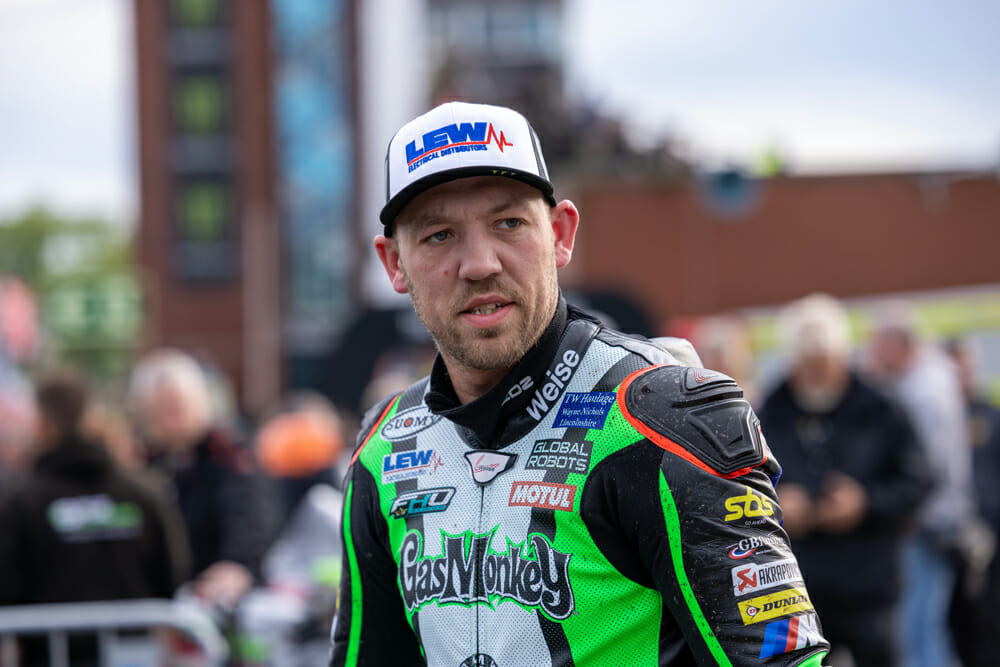 Peter Hickman is the current king and lap-record holder at the Isle of Man.
Peter Hickman is the current king and lap-record holder at the Isle of Man.
That destiny is controlled by a simple tap on the shoulder from the official race starter, letting you know it’s your turn to face the challenge of the Snaefell Mountain Course. In the increasing digitization of our world, the TT retains this beautifully simple tradition, one that provides what for some is a final human touch.
I can tell you from personal experience—that touch is something you hardly feel because you’re so focused on the starting control panel to the top right of your vision your body almost goes numb.
Senior TT winner and all-time lap record holder Peter Hickman says there are varying levels of understanding with the TT that make it genuinely hard to explain the experience.
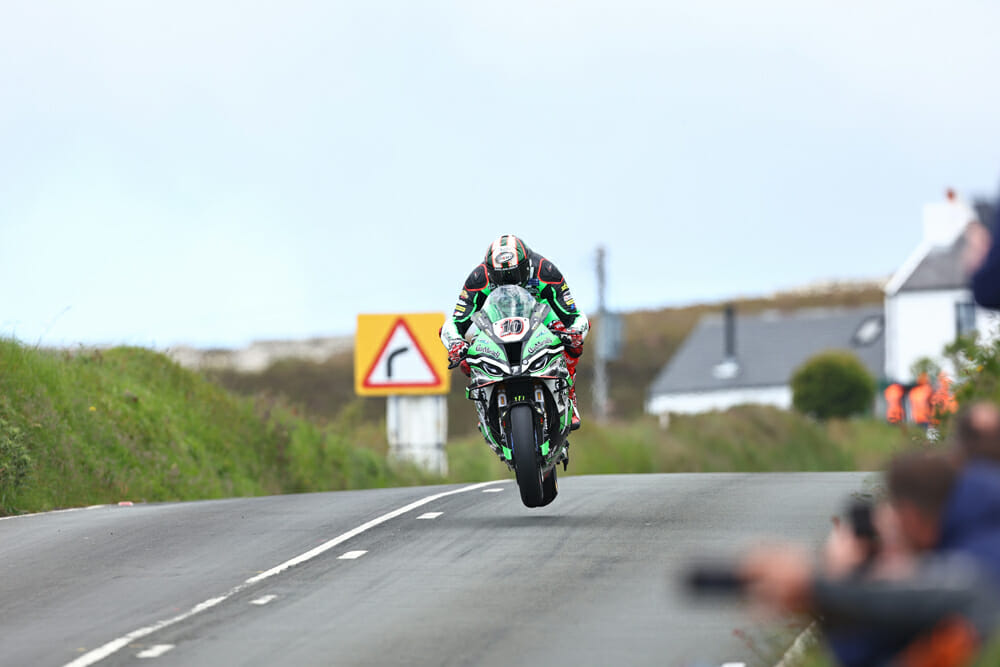 Flying through the air at 140 mph. Hickman is certainly spectacular to watch.
Flying through the air at 140 mph. Hickman is certainly spectacular to watch.
“Unless you’ve been here and seen what the TT is all about, I really don’t think it’s describable. Words don’t do it justice,” he said mere hours after winning the 2022 Senior TT. “If you’ve been here as a spectator, you’ll understand a little bit; if you’ve ridden your own bike around the track, you’ll get it a bit more, and anyone lucky enough to have done a closed-roads lap will get a little bit more again.
“But if you’ve been one of the few that’s raced here, those are the ones that truly get it. That feeling is absolutely unlike anything else I have ever felt.”
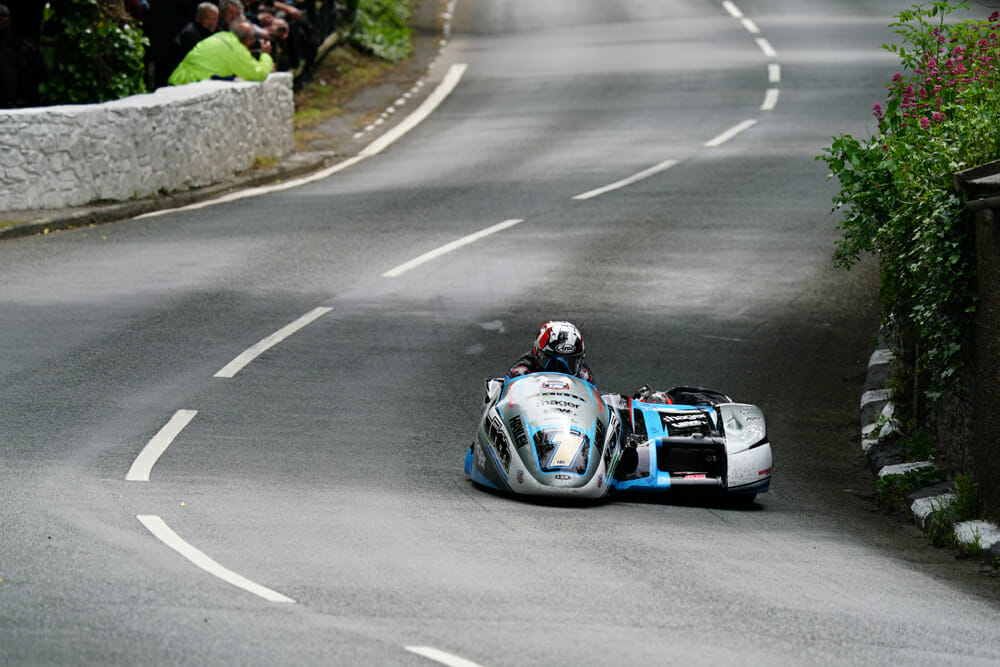 Brothers Tom and Ben Birchall dominated a tragic event for the sidecar contingent.
Brothers Tom and Ben Birchall dominated a tragic event for the sidecar contingent.
While there are many road races across Northern Ireland and mainland Europe in the form of the International Road Race Championship, the TT remains the grandfather of them all. It has become so ingrained in the Isle of Man’s DNA that the place would be lost without it. Although the 2022 race’s economic impact has yet to be measured, the last time the race ran in 2019, it bought in around $45 million to the local economy. The island’s population explodes during those two weeks, with bikes constantly coming and going via the Steam Packet ferry that takes riders from Liverpool in the UK to the port of Douglas on the Isle of Man and motorcycle nirvana.
The people come to watch something extraordinary.
Nowhere else can you get so close to riders doing 185 mph, the rushing wind bringing a delayed cacophony of noise like a fighter jet breaking the sound barrier.
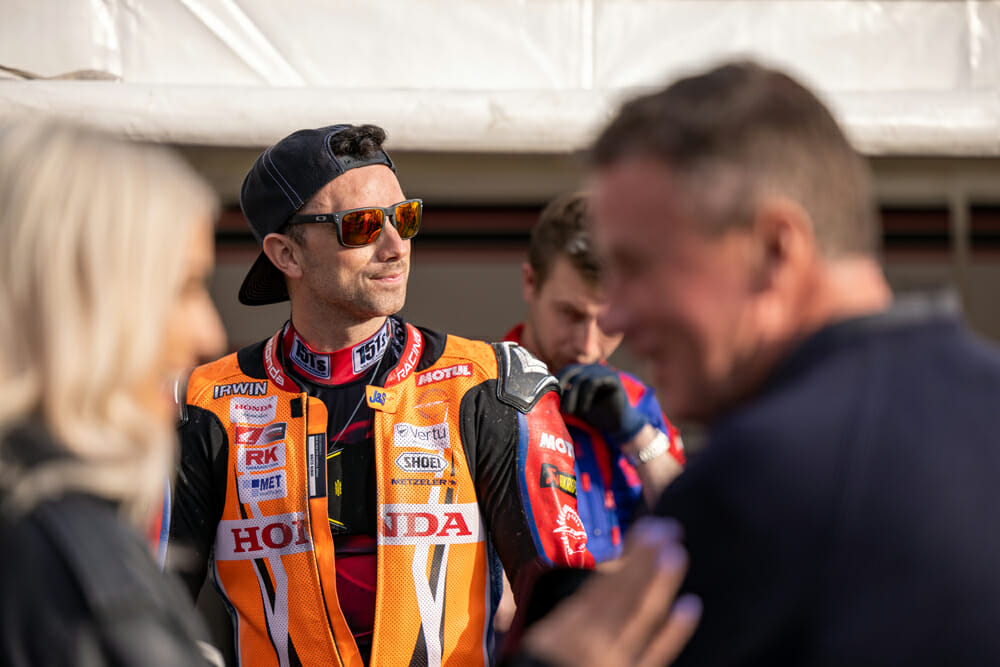 Glenn Irwin is a BSB star and now the fastest-ever rookie at 129.8 mph average.
Glenn Irwin is a BSB star and now the fastest-ever rookie at 129.8 mph average.
To sit at Hillberry and watch Hickman, McGuinness, Dunlop and Harrison whiz past so close you could touch them is a surreal feeling. However, from the handlebars, it feels like you’re the artist in a constantly evolving water painting. Colors blend from the trees to the fences and various buildings, and you can see the look of exhilaration and terror on some spectators’ faces as you sit up for braking—not because you’re looking for them, but because they are so close, you can’t not see them.
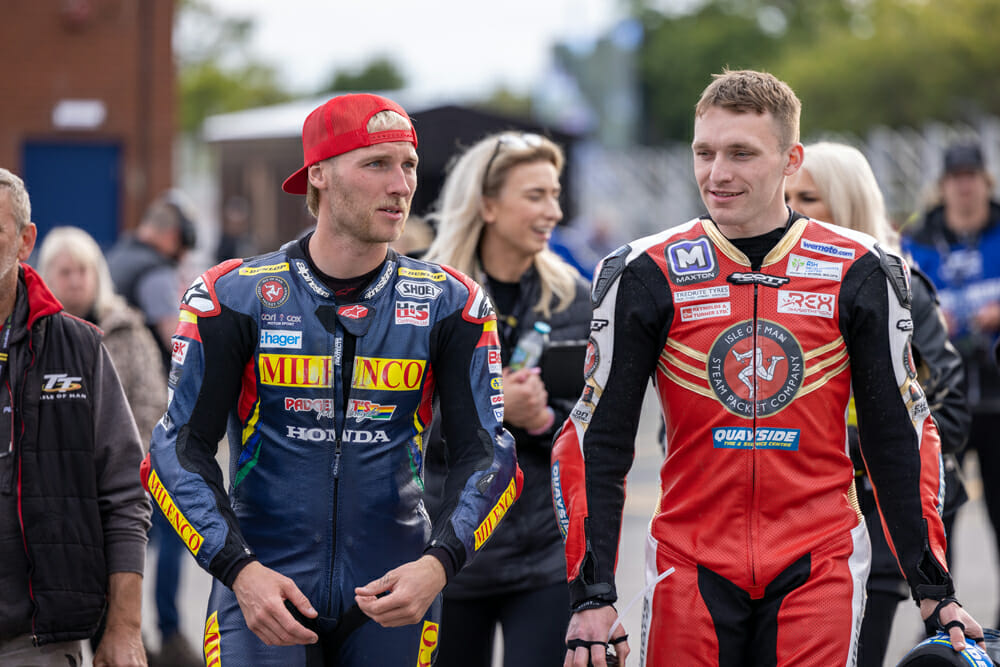 Davy Todd (left) and Nathan Harrison (right) are part of the new wave of TT stars.
Davy Todd (left) and Nathan Harrison (right) are part of the new wave of TT stars.
As Green As The Hedges
2022 was my first foray at the Isle of Man. Having spent the past three years getting fit by racing as much as possible in Southern California, I felt I was ready to take on the TT challenge. But I’ll freely admit it was one I completely underestimated. The battering my body took was far different from what I was used to on the short tracks of America. My shoulders, in particular, took such a hammering after the first night of practice I could barely lift my left arm.
The constant jackhammering the circuit imparts—first to the motorcycle and then to the human body—cannot be overstated. You need to use your ankles, knees, hips, wrists, elbows and shoulders all as independent springs, constantly moving and adjusting your position on the motorcycle with your butt rarely touching the seat over the course of the lap.
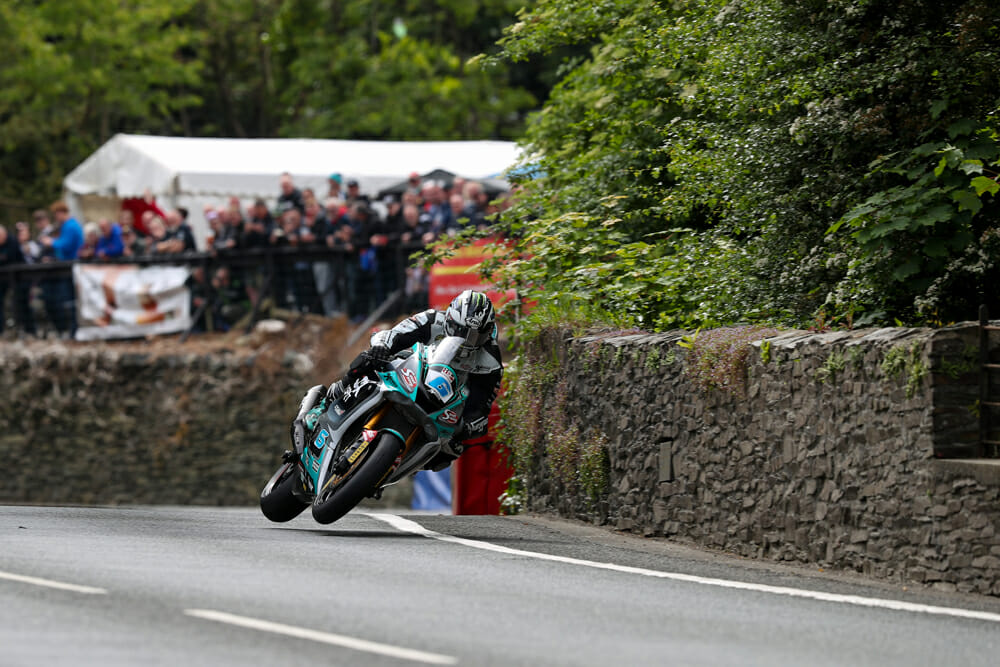 Michael Dunlop launches his Yamaha through the Union Mills section.
Michael Dunlop launches his Yamaha through the Union Mills section.
At times, you need to ride your road racer like a dirt bike—butt off the seat, weight tilted towards the rear of the bike, allowing it to track where it wants and let the suspension do its job. Places like the mile-long straight after the sixth-gear Ballacrye jump are dealt with by minimal handlebar inputs, the rider simply angling the motorcycle into the direction of travel and letting the mechanical forces take care of themselves.
The TT course really lets you know just how good you are—or aren’t. Former 250 GP star Jamie Robinson once told me a story about getting completely blown away by a rider near twice his size because the TT course is all about carrying as much speed as possible out of the corner for the next long straight.
Speed multiplication has never been more apparent to me than it is at the TT—a rider going five miles per hour faster on the exit of the corner will have gained seconds on you by the time you reach the end of a two-mile straight. It’s a demoralizing feeling being on the wrong side of that equation and a beautiful one if on the right side.
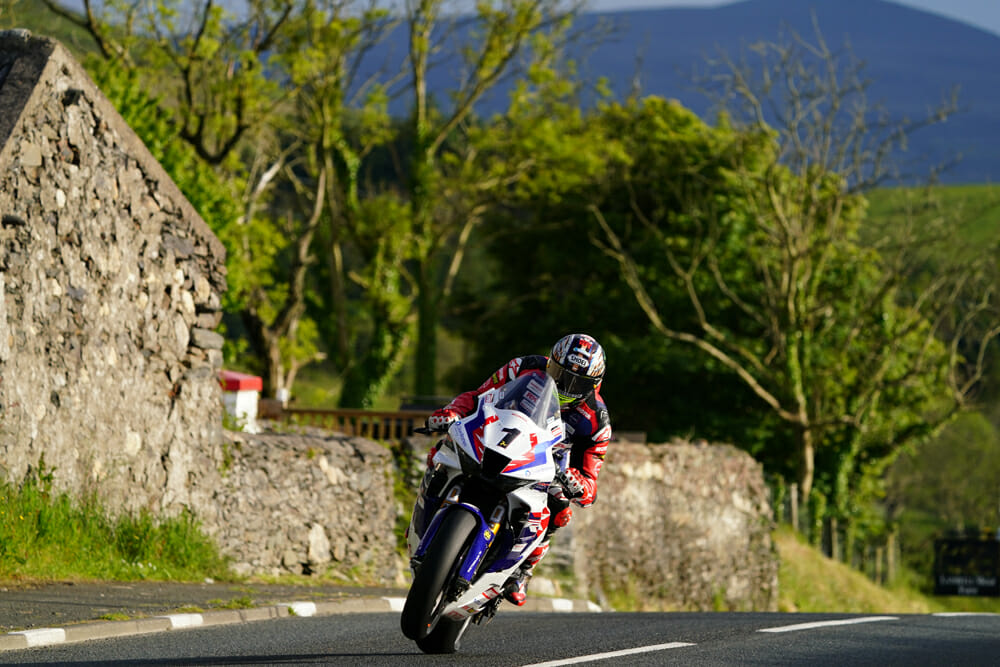 The Superbike TT saw John McGuinness notch up his 100th TT start.
The Superbike TT saw John McGuinness notch up his 100th TT start.
But the big thing you need to get used to is the sheer, brain-melting speed. I calculated that my winning average speed at Pikes Peak in 2019 was 58 mph. By the fourth night of practice at the TT, I’d doubled that to 117 mph, and I was still not even in the top 20. The chronic speed means your brain’s synapses are firing harder than ever—from Union Mills to Greeber Castle, you only roll slightly for Ballagarey, but the rest is absolutely flat out. That section is nearly five miles long and you’re hardly ever going straight. No wonder my eyes felt like they were going to pop out of my head each night.
There are sections of the TT course that make you truly glad to be alive. Plunging down over Ballig Bridge into Doran’s Bend, through Laurel Bank and into the Glen Helen section is pure dopamine overload, you and your motorcycle surfing the smooth grey strip beneath you and the trees forming a glorious green tunnel.
On the flip side, exiting Ginger Hall into Kerrowmoar and then past the Glen Duff post office at top speed with the motorcycle tying itself in knots underneath you is terrifying for the first-timer, but a little trick I taught myself at Pikes Peak worked well here.
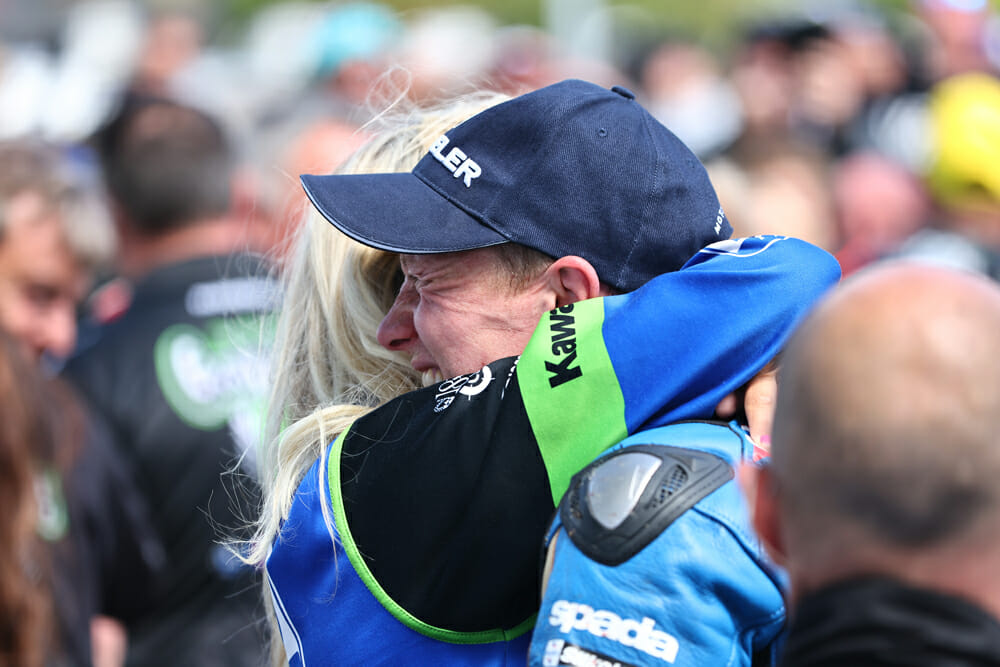 Home, safe and sound. Dean Harrison embraces his team following the Superbike TT.
Home, safe and sound. Dean Harrison embraces his team following the Superbike TT.
Back in my Pikes Peak years, I always struggled from Devil’s Playground to the Summit. This is the balls-to-the-wall section, the highest sustained top speed area of the course, and the point when you really must lay it on the line. One morning, I told myself, “You love this section, you love it,” and I made myself repeat it enough times until it was true. Sure enough, this became one of my best parts of the track, so I employed the same trick for Glen Duff, and, despite it being categorically the bumpiest section of the track, I learned to love it.
However, my favorite part of the track was the Mountain. After so much time in the trees, the Mountain takes over and you’re suddenly on a totally different racetrack. The dark of the overhanging branches gives way to enormous vision with no real blind corners, and when you crest the highest point of the track at Hailwood Heights, all of a sudden, gravity is working with you and the speed increases exponentially. You’re throwing gears at the bike all the time as you roll down the mountain towards the Creg-Ny-Baa hotel—it’s a glorious, other-worldly feeling.
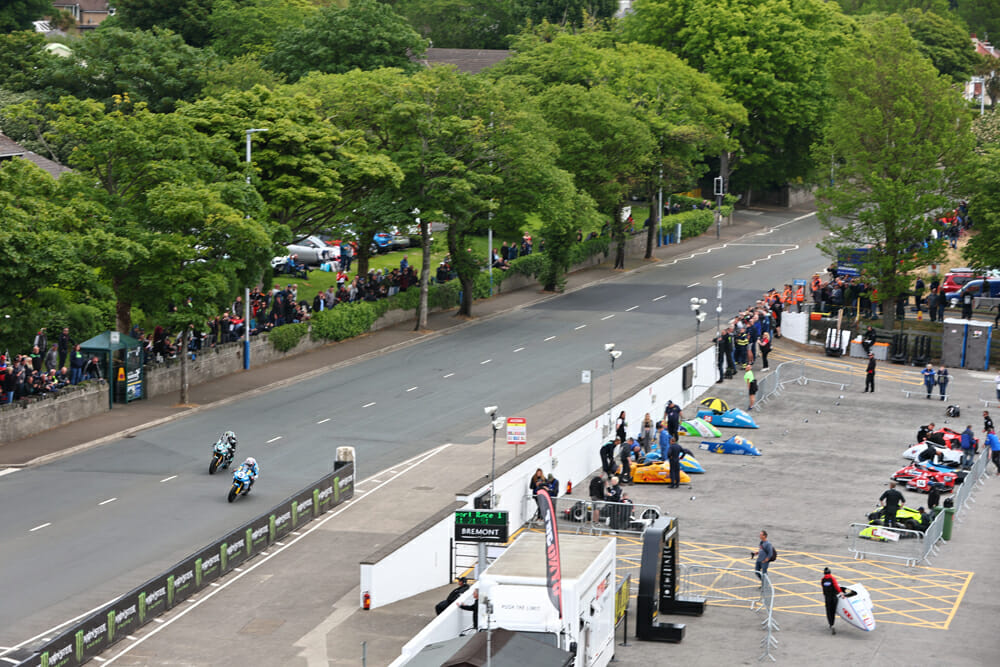 Lee Johnston (3) and Michael Dunlop (6) drag race their way down Glencrutchery Road.
Lee Johnston (3) and Michael Dunlop (6) drag race their way down Glencrutchery Road.
Loved and feared in equal measure, the TT Mountain Course takes absolutely no prisoners and punishes those who make even a slight transgression. Broken bikes and bodies are a common sight at the TT, but you must tell yourself, “There’s someone helping that guy.” Put it out of your mind and attack the next part of the course—or you could be next.
In that sense, the TT Mountain Course is the absolute motorcycle equivalent of Mount Everest—this is the greatest challenge in racing.
So, how did I do over the two weeks as a TT racer? Stay tuned next week for my blow-by-blow account of life as a TT rookie. CN
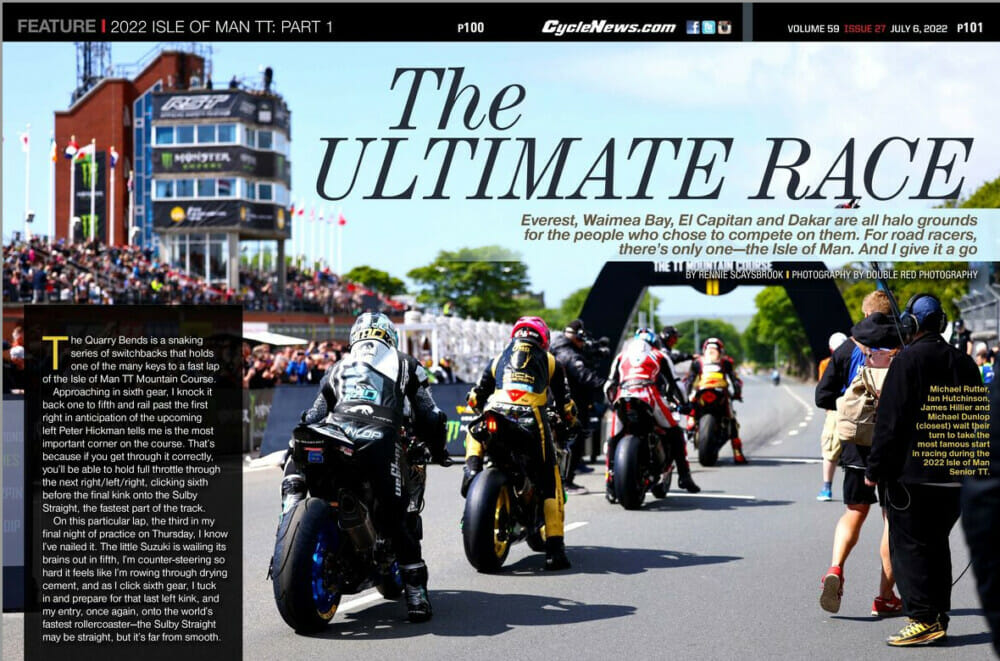
Click here to read 2022 Isle of Man TT Part 1 in the Cycle News Digital Edition Magazine.